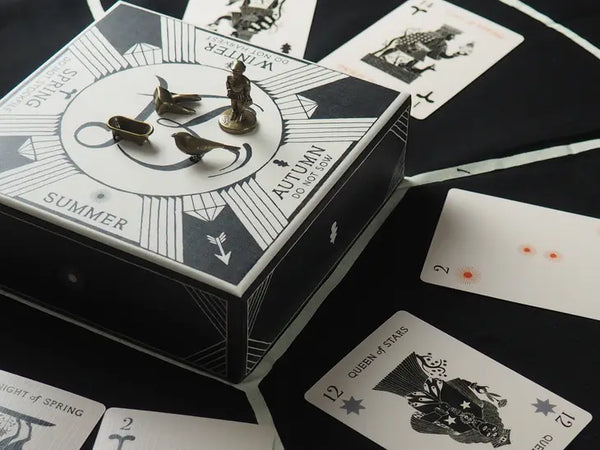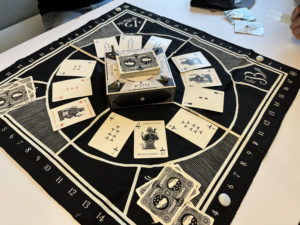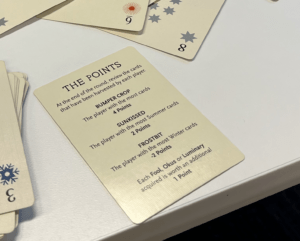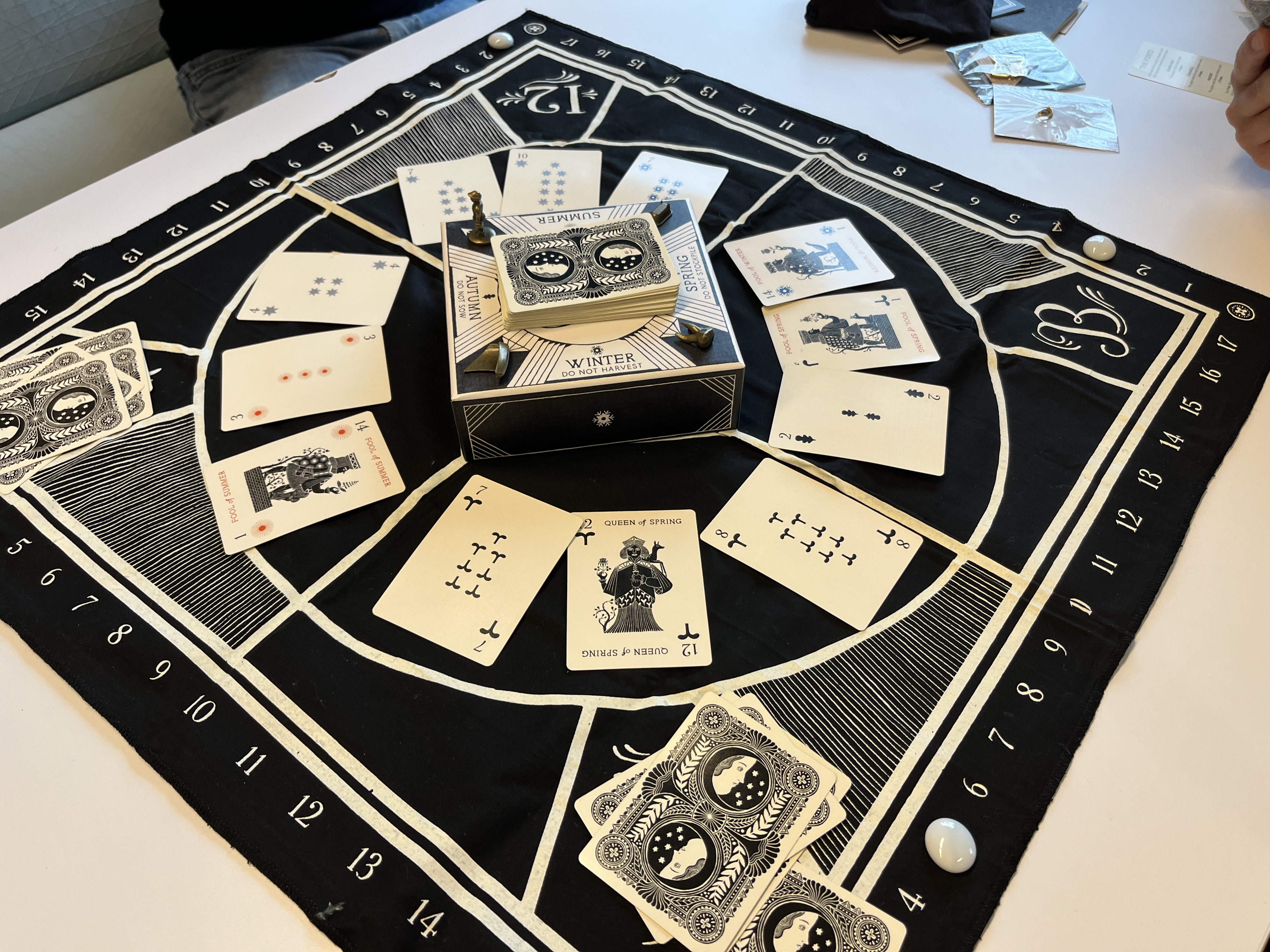For this competitive analysis critical play, I chose the game Illimat, designed by Keith Baker and illustrated by Carson Ellis. Illimat is a 2-4 player game with a target audience of 12+ with each round lasting 20-50 minutes. It’s a modern card game in which players earn points by collecting cards from the “field” mat, divided into four regions, each governed by seasonal rules affecting gameplay (season per region determined by center box orientation). Players must strategically sow (place cards down on the mat), harvest (collect cards based on value matching criteria), or stockpile cards (stack cards on the mat to accumulate values), adapting their tactics as the seasons change around the board. Round winners are determined based on a predetermined point system (e.g. most summer cards, most cards total, etc).
Note: this was written before we slightly adjusted our game’s mechanics so the similarities may be a bit of a reach now.
Argument: While Illimat loosely shares our game’s concept of sectors and has elements of rotating power dynamics and a predetermined multi-round point system based on card collection, it contrasts significantly in terms of the actual round mechanics with our game emphasizing more direct negotiation between players and the notion of fulfilling hidden objectives through resource acquisition rather than accruing points based on card combinations and matching; additionally, we found Illimat to be quite inspirational for us in its use of a variety of physical components for enhancing sensory fun, something we currently do sparingly, relying mostly on cards.
In Illimat, there is not a true idea of maintaining power, with players working independently to achieve the most points. However, when players play using a seasonal face card (e.g. Queen of Spring), the box in the middle of the mat rotates so that the season matching the face card is pointed towards you. Each season creates restrictions for the sector it overlaps with and because you can harvest from any sector except Winter (not just the one pointed towards you), this leads to interesting dynamics like intentionally playing with a Winter face card to prevent others from harvesting in your sector (if that sector seems to have the most potential for creating good card combinations).

Other than this rotating box mechanic, there is no concept of a higher power or leader in the game and players don’t directly interact. In contrast, our game relies heavily on the concept of an Emperor, equipped with one Monarch card and ten Resource cards at a time, while the other players start as nobles and are dealt two Crisis cards. During each round, the Emperor seeks to maintain their position by negotiating deals with the nobles to resolve crises, aiming to meet specific conditions outlined on their Monarch card or by managing the crises effectively. Shifting power dynamics are created if the Emperor fails to meet their objectives, result in deposing and rotation to a new Emperor. For Illimat, a deck building game, the social elements from fun come mostly from the excitement (or disappointment) created when a player harvests a card that another wanted or they stockpile by combining two cards on the mat that someone could have harvested if the card values were individual. Because no one is aware of what cards the others have, the social aspects rely less heavily on direct player-player interaction. However, the thrill that our game creates for a player when they successfully embezzle a resource from the emperor, although it ensures more direct interaction between players, is still somewhat mirrored in Illimat (when a player successfully blocks another player from making a move they wanted or when a player harvests multiple cards in a single turn).
Unlike our current version of the game Illimat relies more heavily on the physical components of the game for promoting fun (particularly sensory), something we wish to begin emulating. Illimat relies heavily on visualization of the seasonal sectors on a mat for gameplay, as cards are directly placed in these regions and certain moves mentioned above can manipulate the allowable moves in a sector.

Currently, our idea of “sectors” is limited to simply having 4 different nobles assigned general emergencies that are not directly associated with a particular noble type. We kept this simple for the purposes of our first prototype, but ideally in our next design/marketing stage we would like to adopt a more tangible sector idea like Illimat’s in which each noble is a named ruler of a region in the realm and the emergencies they are tasked with are themed accordingly (e.g. Noble Qutuz x “Fight off the Mongol Invasion”). This would help improve the narrative and fantastical elements of fun for our game. Illimat also has physical metal tokens that are placed at the corner of the rotating season box. If a player manages to clear all 3 cards in a particular sector, they are awarded a token which is automatically worth 1 point. We currently have a concept of 5 point “legacy tokens” that can be awarded to the emperor upon fulfilling his assigned objectives or may appear as a random award on a crisis card for a noble. Compared with Illimat, in our game, the chance of earning a token is quite asymmetrical. I do like the idea of having physical tokens that represent what kind of noble you are (although this may introduce more components than necessary). Finally, Illimat has a physical method for tracking points at the end of each round: each of the 4 sides of the mat are numbered 1-17 and each player is given a white stone they can use to mark their position at the end of a round with points accumulating until 17 is reached first by a player. There is also a physical card that has a list of the methods for earning points. In our game, we also have a single card that has the point assignments per resource type, but we don’t incrementally track the point progress after each round; the winner is determined solely at the end after counting of accumulated points. If we did have more of a visualization for the sectors, perhaps incremental progress is something we could try to visualize as well.
Similar to our game, Illimat lasts for multiple rounds with different card values resulting in different point values, however the exact mechanics that characterize the end of a round differs. In Illimat, the round ends when no more cards remain in the deck (which are used to maintain 3 cards in each sector at all times) or when no player can harvest or stockpile (unable to match a value in their hand to a value on the mat). In our game, the length of the round is directly proportional to the number of players with each person taking single turns requesting resources from the emperor. Either you solve your crises or emperor objectives or you don’t. In Illimat, if there are no positive moves that can be made, players are forced to sow (put their card down in a sector), incentivizing everyone to put their cards in Winter where no other players can harvest from. Any extra cards in your hand are essentially discarded. In our game, nobles hold on their crisis cards if they didn’t solve them (we are experimenting with whether this is fair and if they should be able to redraw) and have the chance to earn points with those cards in the next round. Like our game, Illimat assigns point values using prescribed rules like: the player with the most harvested cards wins, the player with the most winter cards loses 2 points, each token is worth a point, etc.

In our game, we assign points based on the number of resources embezzled (ore = 4 points, brick = 3 points, wheat = 2 points) and the number of legacy tokens (5 points each). In Illimat, the game ends when a player reaches 17 points (accumulated across rounds). In our game, the stopping condition is when all of the legacy tokens have run out. Illimat also has a concept of negative points (accumulating the most Winter cards), but this is a possibility for any player. In our game, for the emperor, there is still a negative consequence of being overthrown if their objectives are not met but the advisors can’t lose points (the power balance is already quite skewed towards the emperor, so if anything more checks may need to be placed against them).



